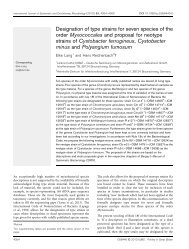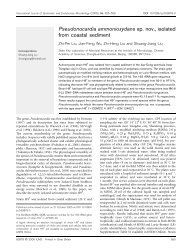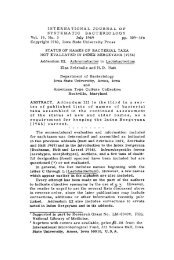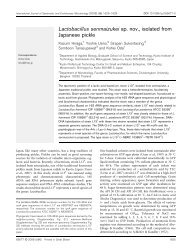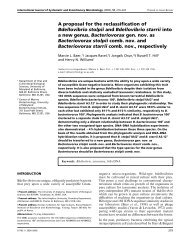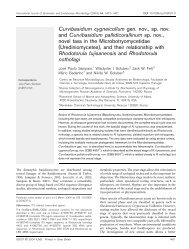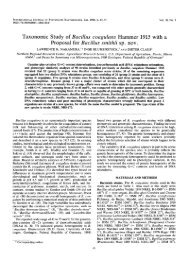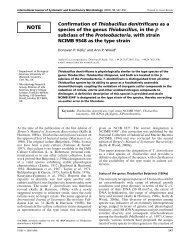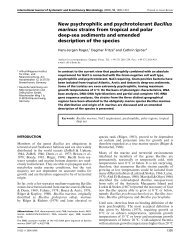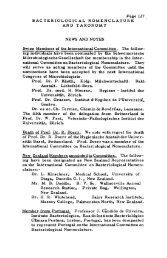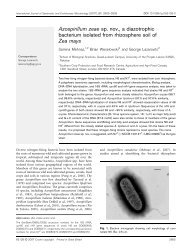Pichia insulana sp. nov., a novel cactophilic yeast from the Caribbean
Pichia insulana sp. nov., a novel cactophilic yeast from the Caribbean
Pichia insulana sp. nov., a novel cactophilic yeast from the Caribbean
You also want an ePaper? Increase the reach of your titles
YUMPU automatically turns print PDFs into web optimized ePapers that Google loves.
P. F. Ganter, G. Cardinali and K. Boundy-Mills<br />
This picture of three globally dominant <strong>sp</strong>ecies began to<br />
change with <strong>the</strong> discovery of sexuality in C. cereanus,<br />
which became Sporopachydermia cereana (Rodrigues De<br />
Miranda, 1978) not long after it was first described. C.<br />
cereanus strains (often referred to in publications as<br />
belonging to <strong>the</strong> C. cereanus ‘complex’) were noted for<br />
<strong>the</strong>ir physiological variability (Lachance, 1998; and our<br />
unpublished data), and reassessment of this variability and<br />
examination of partial LSU rDNA sequences revealed this<br />
global <strong>sp</strong>ecies to be ano<strong>the</strong>r example of a cluster of related<br />
<strong>cactophilic</strong> <strong>sp</strong>ecies (Lachance et al., 2001). Much less<br />
physiological variability has been reported <strong>from</strong> <strong>the</strong> two<br />
remaining global <strong>sp</strong>ecies, even when considerable local<br />
genetic variability was uncovered (Ganter & Quarles,<br />
1997; Ganter et al., 2004). The description of P. <strong>insulana</strong>,<br />
along with <strong>the</strong> previous description of P. pseudocactophila,<br />
makes it possible that <strong>the</strong> most ‘global’ of <strong>the</strong> global<br />
<strong>sp</strong>ecies, P. cactophila, is also a cluster of local, cryptic,<br />
endemic <strong>sp</strong>ecies. An observation and an absence of<br />
observations support this possibility. Some physiological<br />
variation has been found in strains collected <strong>from</strong> nor<strong>the</strong>astern<br />
Brazil, and <strong>the</strong>y may represent ano<strong>the</strong>r <strong>sp</strong>ecies in<br />
<strong>the</strong> complex. The absence of observations results <strong>from</strong> <strong>the</strong><br />
fact that strains identified as P. cactophila <strong>from</strong> most<br />
regions have not yet been examined for consistent patterns<br />
of molecular variation, a means of uncovering cryptic<br />
<strong>sp</strong>eciation when standard identification methods do not<br />
suffice. The global <strong>sp</strong>ecies group may not survive close<br />
scrutiny.<br />
Comparison of <strong>the</strong> distributions of P. <strong>insulana</strong>, P.<br />
cactophila and P. pseudocactophila raises questions that<br />
illustrate our lack of understanding of <strong>yeast</strong> ecology. All are<br />
restricted to <strong>the</strong> <strong>cactophilic</strong> habitat and are phenotypically<br />
indistinguishable. With this degree of overlap, how do all<br />
three coexist within this habitat? There is no consistent<br />
pattern to <strong>the</strong> interactions between <strong>the</strong> wide<strong>sp</strong>read,<br />
generalist <strong>sp</strong>ecies (P. cactophila) and <strong>the</strong> sexual <strong>sp</strong>ecies<br />
with restricted distributions and/or host ranges. All of <strong>the</strong><br />
sequences <strong>from</strong> strains collected on Curaçao belonged to<br />
<strong>the</strong> P. <strong>insulana</strong> clade, whe<strong>the</strong>r or not <strong>the</strong>y produced <strong>sp</strong>ores,<br />
so it is likely that P. cactophila is not found on Curaçao,<br />
making it <strong>the</strong> first <strong>cactophilic</strong> community investigated that<br />
does not include P. cactophila. P. cactophila is found<br />
throughout <strong>the</strong> <strong>Caribbean</strong> and in Venezuela, so chance<br />
does not seem a likely reason for its absence <strong>from</strong> Curaçao.<br />
The <strong>cactophilic</strong> <strong>yeast</strong> community of Curaçao was dominated<br />
by P. <strong>insulana</strong> (Table 2), much in <strong>the</strong> way that P.<br />
cactophila dominates <strong>the</strong> <strong>cactophilic</strong> <strong>yeast</strong> community at<br />
many locales (Starmer et al., 1990). The six strains found in<br />
<strong>the</strong> Phaff Yeast Culture Collection show that P. <strong>insulana</strong> is<br />
not confined to Curaçao, but that it is not <strong>the</strong> dominant<br />
<strong>sp</strong>ecies on o<strong>the</strong>r islands, although <strong>the</strong> cacti found <strong>the</strong>re are<br />
closely related to those on Curaçao, so host differences are<br />
not <strong>the</strong> most likely explanation for <strong>the</strong> switch <strong>from</strong><br />
dominance to rarity. The situation of P. <strong>insulana</strong> on<br />
islands o<strong>the</strong>r than Curaçao is similar to that of P.<br />
pseudocactophila in <strong>the</strong> Sonoran Desert. P. pseudocacto-<br />
phila, which is restricted to cacti of <strong>the</strong> Pachycereinae, is<br />
rarer on its only hosts than is P. cactophila. Although <strong>the</strong><br />
standard assimilation tests were developed to utilize<br />
substrates found in a generalized <strong>yeast</strong> habitat, our lack<br />
of insight into <strong>cactophilic</strong> ecology might simply result <strong>from</strong><br />
<strong>the</strong> fact that <strong>the</strong>se tests do not characterize <strong>the</strong> most<br />
ecologically relevant characteristics for this habitat. O<strong>the</strong>r<br />
possibilities abound. We may need to include larger-scale<br />
killer factor screenings (<strong>the</strong> ability to kill Candida glabrata<br />
Y-55 was <strong>the</strong> only killer screening done) or regularly<br />
include information on a <strong>sp</strong>ecies’ animal vectors before we<br />
can discern ecologically relevant differences between <strong>the</strong>se<br />
<strong>sp</strong>ecies.<br />
We have found no single physiological test that will allow<br />
one to distinguish P. <strong>insulana</strong> <strong>from</strong> P. cactophila and P.<br />
pseudocactophila. As part of <strong>the</strong> search for such a<br />
distinguishing physiological character, we tried growing<br />
strains of each at 45 uC. The results came as close to success<br />
as any character we tried. All P. <strong>insulana</strong> strains <strong>from</strong><br />
Curaçao grew strongly at that temperature and none of <strong>the</strong><br />
several P. cactophila strains we tested were able to grow at<br />
45 uC, although <strong>the</strong>re have been reports of some variability<br />
among P. cactophila strains in growth at this elevated<br />
temperature. There were two problems with this character<br />
as a means of separating <strong>the</strong>se three <strong>sp</strong>ecies: <strong>the</strong> type strain<br />
of P. pseudocactophila also grew strongly at 45 uC and, of<br />
<strong>the</strong> six P. <strong>insulana</strong> strains identified <strong>from</strong> <strong>the</strong> Phaff Culture<br />
Collection, four did not grow at 45 uC, one grew weakly<br />
and <strong>the</strong> o<strong>the</strong>r strongly. These six strains were all collected<br />
over 25 years ago, and <strong>the</strong> failure of four to grow at<br />
elevated temperature may be an artefact of <strong>the</strong>ir long<br />
laboratory residence, but we cannot resolve this discrepancy<br />
here. However, growth at 45 uC, if combined with<br />
collection locale, may help with preliminary identification<br />
of strains of <strong>the</strong>se <strong>sp</strong>ecies.<br />
ACKNOWLEDGEMENTS<br />
This study was greatly aided by William T. Starmer of Syracuse<br />
University, who generously dissected six asci for us. P. F. G.<br />
acknowledges <strong>the</strong> support of NIH grant S06-GM08092 subproject 4<br />
that made collection of <strong>the</strong> strains <strong>from</strong> Curaçao possible.<br />
REFERENCES<br />
Ganter, P. F. & Quarles, B. (1997). Analysis of population structure of<br />
<strong>cactophilic</strong> <strong>yeast</strong> <strong>from</strong> <strong>the</strong> genus <strong>Pichia</strong>: P. cactophila and P.<br />
norvegensis. Can J Microbiol 43, 35–44.<br />
Ganter, P. F., Cardinali, G., Giammaria, M. & Quarles, B. (2004).<br />
Correlations among measures of phenotypic and genetic variation<br />
within an oligotrophic asexual <strong>yeast</strong>, Candida sonorensis, collected<br />
<strong>from</strong> Opuntia. FEMS Yeast Res 4, 527–540.<br />
Heed, W. B., Starmer, W. T., Miranda, M., Miller, M. W. & Phaff, H. J.<br />
(1976). An analysis of <strong>the</strong> <strong>yeast</strong> flora associated with cactiphilic<br />
Drosophila and <strong>the</strong>ir host plants in <strong>the</strong> Sonoran Desert and its relation<br />
to temperate and tropical associations. Ecology 57, 151–160.<br />
Holzschu, D. L., Phaff, H. J., Tredick, J. & Hedgecock, D. (1983).<br />
<strong>Pichia</strong> pseudocactophila, a new <strong>sp</strong>ecies of <strong>yeast</strong> occurring in necrotic<br />
1006 International Journal of Systematic and Evolutionary Microbiology 60



